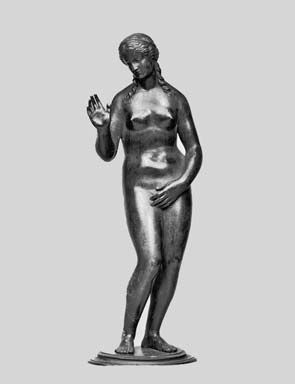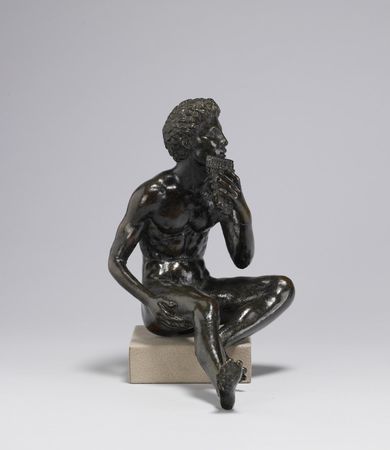"Touch and the Enjoyment of Sculpture: Exploring the Appeal of Renaissance Statuettes" @ he Walters Art Museum
Anonymous (Italian), Modest Venus (Venus Pudica), ca. 1500, bronze with dark brown lacquer patina, silver, 10 ½”, The Walters Art Museum, The Walters Art Museum, Baltimore (54.244)
“Please DO NOT touch” is the message that we are all used to seeing on signs near works of art in most museums. This is necessary to preserve the art, but we all want to touch! This focus show invites you to touch…and hold, and stroke and to think about why and how physical contact with works of art can be so satisfying. As a continuation of the Walters partnership with The Johns Hopkins University Brain Science Institute, this installation incorporates 12 works of art from the collection and 22 models for visitors to touch and rate. This melds research interests of Steve Hsiao, a John Hopkins neuroscientist specializing in the many facets of touch, with those of Joaneath Spicer, Walters curator of Renaissance and Baroque art, exploring the new importance of touch in the Renaissance, specifically the popularity of collecting statuettes and other objects, including new hand-held technology.
Visitors will learn about this new interest on the part of Europeans around 1500, in art that was pleasurable to hold—such as a statuette of Venus the ancient goddess of love that nestles into your hand—and objects apparently made to fit in the hand such as the earliest watches or the evolving shape of the personal firearm.
The special appeal of this installation, however, will surely be the opportunity to join in comparative experiments with statuettes (replicas) and other thought-provoking hands-on touch comparisons. What types of surfaces do you prefer? Does knowledge of the subject of a sculpture influence how you react to it? What happens to our satisfaction in a piece if something about it changes? What is the impact of sight on the sense of touch? Visitors will register their preferences through “touch pads,” thereby reminding visitors of yet another aspect of touch as a vehicle for communication. To extend an awareness of touch and how painters have taken advantage of our sensitivity to touch, photographic details of paintings and sculptures throughout the museum will provide visitors with incentives to explore the topic further on their own. With the assistance of the Maryland State Library for the Blind and Physically Handicapped, all text materials will be available in Braille and visits by the visually challenged can be scheduled.
Touch and the Enjoyment of Sculpture: Exploring the Appeal of Renaissance Statuettes has been organized by the Walters Art Museum in partnership with The Johns Hopkins University School of Medicine Brain Science Institute (BSI), which has also provided generous support for the project. The BSI’s mission is to solve fundamental questions about brain development and function and to use these insights to understand the mechanisms of brain disease and health
Andrea Riccio, The Shepherd Daphnis with Pipes, 1520-1530, bronze, 21.3 cm, The Walters Art Museum, Baltimore

/https%3A%2F%2Fprofilepics.canalblog.com%2Fprofilepics%2F1%2F0%2F100183.jpg)
/https%3A%2F%2Fstorage.canalblog.com%2F03%2F02%2F119589%2F96711876_o.jpg)
/https%3A%2F%2Fstorage.canalblog.com%2F11%2F31%2F119589%2F94773502_o.jpg)
/https%3A%2F%2Fstorage.canalblog.com%2F20%2F83%2F119589%2F94772815_o.jpg)
/https%3A%2F%2Fstorage.canalblog.com%2F26%2F72%2F119589%2F75604929_o.jpg)
/https%3A%2F%2Fstorage.canalblog.com%2F59%2F60%2F119589%2F26458628_o.jpg)




/http%3A%2F%2Fstorage.canalblog.com%2F79%2F29%2F119589%2F129500486_o.jpg)
/http%3A%2F%2Fstorage.canalblog.com%2F06%2F72%2F119589%2F129500034_o.jpg)
/http%3A%2F%2Fstorage.canalblog.com%2F35%2F97%2F119589%2F110342649_o.jpg)
/http%3A%2F%2Fstorage.canalblog.com%2F18%2F57%2F119589%2F110079933_o.jpg)